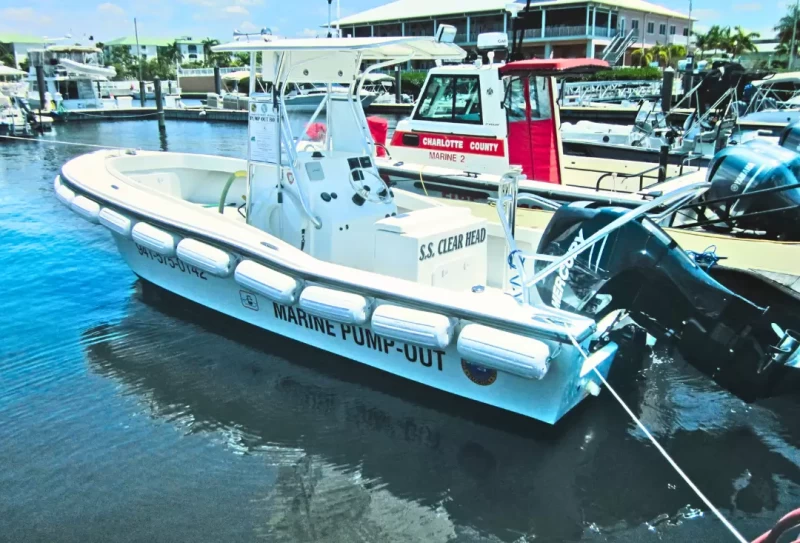
Up until the late 1980s, many boaters simply discharged their untreated sewage overboard into the water. After a revision to the Clean Water Act was passed in 1987, the discharge of untreated sewage into U.S. waters within the 3-mile limit was prohibited.
Shortly thereafter, pump-out stations became a regular feature at marinas and fuel docks throughout the U.S. waterways. Simply stated, if you have a marine head installed on your vessel and are operating in coastal waters within the U.S. 3-mile limit (basically all of the waters covered in the guide you are now holding), you need to have a holding tank and you will obviously need to arrange to have that tank pumped out from time to time.
Government regulation aside, properly disposing of your waste is good environmental stewardship. While your overboard contribution to the waterways may seem small in the grand scheme of things, similar attitudes among fellow boaters can quickly produce unsavory conditions in anchorages and small creeks. The widespread availability of holding tank gear and shoreside pump-out facilities leaves few excuses for not doing the right thing.
No-Discharge Zones
No-Discharge means exactly what the name suggests: No waste, even waste treated by an onboard Type I marine sanitation device (MSD), may be discharged overboard. All waste must be collected in a holding tank and pumped out at an appropriate facility. Keep in mind that there are some areas that forbid overboard discharge of any waste, including gray water from showers or sinks. Familiarize yourself with local regulations before entering new areas to ensure you don't get hit with a fine.
The Law
If you have a marine head onboard and are operating on coastal waters within the U.S. three-mile limit (basically all of the waters covered in this guide), you need to have an approved holding tank or Type I MSD. In a No-Discharge area even a Type I MSD system must have a holding tank.
-
All valves connected to your holding tank or marine head that lead to the outside (both Y-valves AND seacocks) must be wire-tied, padlocked or absent of the valve handle and in the closed position. Simply having them closed without the (non-releasable) wire ties will not save you from a fine if you are boarded.
-
You may discharge waste overboard from a Type I MSD in all areas except those designated as No-Discharge Zones. A Type I MSD treats waste by reducing bacteria and visible solids to an acceptable level before discharge overboard.
-
While small and inconvenient for most cruisers, "Port-A-Potties" meet all the requirements for a Type III MSD, as the holding tank is incorporated into the toilet itself.
NEW: Pump-Out App
Pumpout Nav, a free iOS and Android app, uses a boater's location information to suggest the nearest public pump-out station on a map or list. (Right now it just covers Florida and Lake Champlain.) The app helps boaters find the amenities they need and helps marinas promote their services. The app catalogs more than 250 pump-out stations along the coast and in some inland waterways and provides the cost, hours and detailed location for each facility.
Types of Marine Sanitation Devices
Type I MSD: Treats sewage before discharging it into the water using maceration. The treated discharge must not show any visible floating solids and must meet specified standards for bacteria content. Raritan's Electro Scan and Groco's Thermopure systems are examples of Type I MSDs. Not permitted in No-Discharge Zones.
-
Type II MSD: Type II MSDs provide a higher level of waste treatment than Type I units and are larger as a result. They employ biological treatment and disinfection. These units are usually found on larger vessels due to their higher power requirements. These may not be discharged in No-Discharge Zones.
-
Type III MSD: Regular holding tanks store sewage until the holding tank can either be pumped out to an onshore facility or the "Y" valve can be open to legally discharge directly overboard when offshore (3 miles or more–oceans only). When not offshore, "Y" valve must be closed.
Composting Heads
Composting heads are essentially Type III MSDs but rather than simply storing sewage, composters separate liquid and solid waste, which speeds up decomposition and reduces odors. This "dry" system promotes decomposition through controlled composting in which the solid portion is converted into an easy-to-handle, safe, non-odorous humus. There is no need for plumbing, valves, pump or thru-hull and no components to break down, clog up or leak. Other advantages include no pump-outs, uses no water, reduces onboard weight and opens up storage space.
Penalties and Fines
Misuse or failure to equip a vessel with a Marine Sanitation Device may result in a non-criminal infraction with a $56 penalty.
-
Illegal dumping/discharge of a Marine Sanitation Device may result in a non-criminal infraction with a $250 penalty.
Additional Resources












